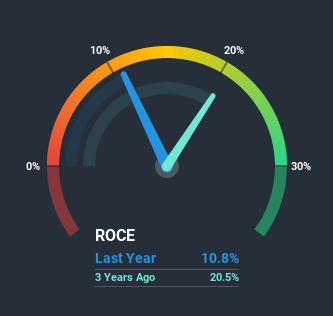Should You Be Impressed By ManpowerGroup's (NYSE:MAN) Returns on Capital?

If we want to find a potential multi-bagger, often there are underlying trends that can provide clues. Typically, we'll want to notice a trend of growing return on capital employed (ROCE) and alongside that, an expanding base of capital employed. Basically this means that a company has profitable initiatives that it can continue to reinvest in, which is a trait of a compounding machine. Having said that, from a first glance at ManpowerGroup (NYSE:MAN) we aren't jumping out of our chairs at how returns are trending, but let's have a deeper look.
Return On Capital Employed (ROCE): What is it?
For those who don't know, ROCE is a measure of a company's yearly pre-tax profit (its return), relative to the capital employed in the business. To calculate this metric for ManpowerGroup, this is the formula:
Return on Capital Employed = Earnings Before Interest and Tax (EBIT) ÷ (Total Assets - Current Liabilities)
0.11 = US$488m ÷ (US$8.5b - US$3.9b) (Based on the trailing twelve months to June 2020).
Thus, ManpowerGroup has an ROCE of 11%. In absolute terms, that's a pretty normal return, and it's somewhat close to the Professional Services industry average of 10%.
See our latest analysis for ManpowerGroup
Above you can see how the current ROCE for ManpowerGroup compares to its prior returns on capital, but there's only so much you can tell from the past. If you'd like, you can check out the forecasts from the analysts covering ManpowerGroup here for free.
The Trend Of ROCE
When we looked at the ROCE trend at ManpowerGroup, we didn't gain much confidence. Over the last five years, returns on capital have decreased to 11% from 19% five years ago. And considering revenue has dropped while employing more capital, we'd be cautious. This could mean that the business is losing its competitive advantage or market share, because while more money is being put into ventures, it's actually producing a lower return - "less bang for their buck" per se.
On a side note, ManpowerGroup's current liabilities are still rather high at 47% of total assets. This can bring about some risks because the company is basically operating with a rather large reliance on its suppliers or other sorts of short-term creditors. While it's not necessarily a bad thing, it can be beneficial if this ratio is lower.
The Bottom Line On ManpowerGroup's ROCE
We're a bit apprehensive about ManpowerGroup because despite more capital being deployed in the business, returns on that capital and sales have both fallen. And, the stock has remained flat over the last five years, so investors don't seem too impressed either. Unless these trends revert to a more positive trajectory, we would look elsewhere.
On a final note, we've found 3 warning signs for ManpowerGroup that we think you should be aware of.
While ManpowerGroup may not currently earn the highest returns, we've compiled a list of companies that currently earn more than 25% return on equity. Check out this free list here.
This article by Simply Wall St is general in nature. It does not constitute a recommendation to buy or sell any stock, and does not take account of your objectives, or your financial situation. We aim to bring you long-term focused analysis driven by fundamental data. Note that our analysis may not factor in the latest price-sensitive company announcements or qualitative material. Simply Wall St has no position in any stocks mentioned.
Have feedback on this article? Concerned about the content? Get in touch with us directly. Alternatively, email editorial-team@simplywallst.com.

 Yahoo Sports
Yahoo Sports 
